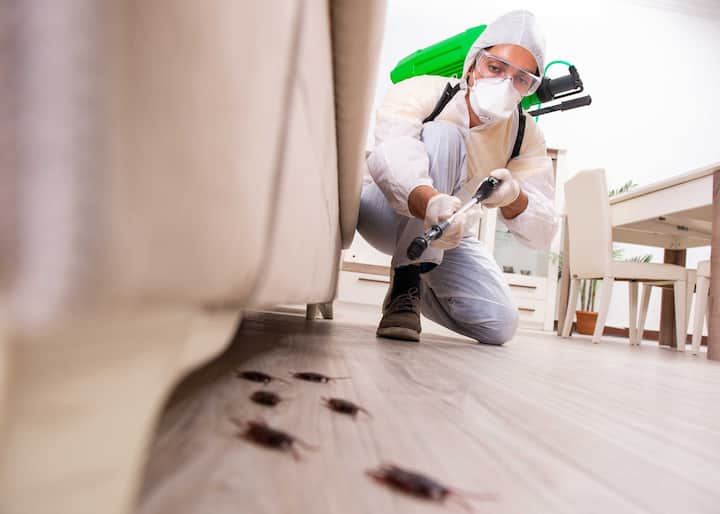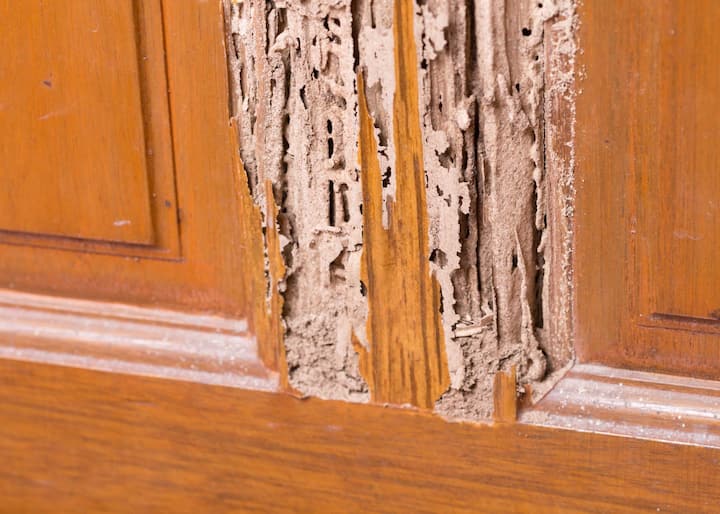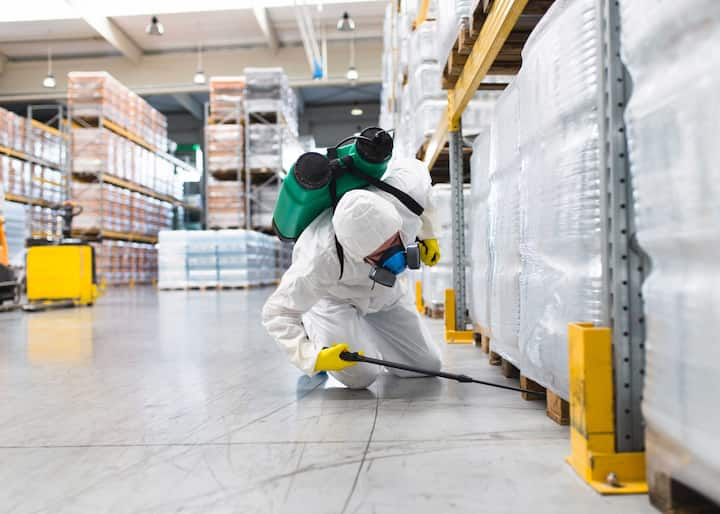Termite inspection professionals ready to serve in St. Louis
Regular termite inspections and removal services for your home are crucial to safeguarding against termite damage. Professional exterminators in St. Louis can provide comprehensive inspections and removal services to ensure your property is termite-free, preventing costly damage and ensuring your peace of mind. In addition to removing any termite infestations, professional exterminators can also diagnose potential issues before they become major problems. By taking proactive measures to protect your home, you can save money in the long run and avoid costly termite damage. For homeowners in St. Louis, Missouri, investing in professional termite removal services is a smart choice for protecting your home and ensuring your peace of mind. Don’t wait until it’s too late – contact a trusted exterminator in St. Louis today.

Identify these indicators of termite infestation damage

Be on the lookout for..
- Presence of termite wings or bodies in your home or near wooden structures
- Hollow or damaged wood in or around your home
- Termite droppings or frass (tiny pellets) around your home or in your attic
- Buckling or sagging floors, ceilings, or walls
- Sounds of rustling or tapping coming from wooden structures in your home, especially at night
- Moisture damage or water stains on your ceiling or walls, which can indicate a termite infestation above your home
- Visible tunnels or mud tubes on the exterior of your home, which termites use to travel between their nest and food sources.

Termites: Silent Destroyers Unmasked
Termites, often considered the “silent destroyers,” are highly destructive pests that pose a significant threat to the structural integrity of homes, businesses, and other wooden structures. These cryptic insects can wreak havoc undetected, leading to costly repairs and potential safety hazards. Here’s an in-depth exploration of termites and their impact, providing you with the knowledge and tools to protect your property against their harmful presence.
1. Understanding Termites: The Basics
Termites belong to the order “Isoptera,” a group of eusocial insects that live in complex and highly organized colonies. Each termite colony operates meticulously under the leadership of a queen and king, with various castes responsible for specific tasks essential for colony survival.
- Workers: The majority of termite colonies, responsible for food gathering, nest construction, and brood care.
- Soldiers: Equipped with powerful mandibles, soldiers defend the colony against intruders and protect their food sources.
- Reproductives: Also known as swarmers, these termites are responsible for creating new colonies.
- Queen: The reproductive powerhouse of the colony, the queen termite lays countless eggs, sustaining the colony’s growth and ensuring its continuity.
- King: The mate of the queen, the king’s sole purpose is to fertilize the queen’s eggs, ensuring the perpetuation of the colony.
Termites exhibit remarkable social behaviors, including highly organized food sharing networks and sophisticated communication systems. They construct intricate nests or tunnels to protect their colony from predators and environmental factors.
2. The Devastating Impact of Termite Infestations
Despite their diminutive size, termites can cause substantial damage to wooden structures. Their relentless feeding habits and ability to infest unnoticed can lead to severe structural damage, resulting in costly repairs and potential safety hazards.
- Structural Weaknesses: Termites primarily target cellulose-rich materials, such as untreated wood and paper. Their relentless burrowing and chewing compromise the structural integrity of beams, joists, and other wooden components, weakening the overall stability of the structure.
- Cosmetic Damage: Termites also leave behind unsightly damage to the aesthetics of your property. They can disfigure wooden surfaces, damaging wallpaper, flooring, and even furniture, resulting in significant repair costs.
- Health Hazards: While termites do not directly transmit diseases to humans, they can contribute to poor indoor air quality. The presence of termite fecal pellets, shed wings, and other debris can trigger allergic reactions and respiratory issues in susceptible individuals.
- Financial Burden: Termite infestations can impose a heavy financial burden on homeowners and business owners. Timely identification and treatment are crucial to minimize the extent of damage and prevent further financial losses.
3. Detecting the Signs of Termite Activity
Early detection of termite activity is paramount to prevent extensive damage and safeguard your property. Here are a few telltale signs to watch out for:
- Mud Tubes: Termites often construct mud tubes to protect themselves from exposure and predators as they travel between their nests and food sources. These tubes, typically pencil-thin, are visible along foundations, walls, and other areas of termite activity.
- Discarded Wings: Swarmers, the reproductive termites, shed their wings after establishing new colonies. Piles of translucent wings near windows, doors, or attic spaces indicate active infestation.
- Hollow-Sounding Wood: Tapping on wood that sounds hollow may be indicative of termite infestation. Termites consume the inner portions of wood, leaving behind a thin shell that produces a hollow sound when tapped.
- Frass: Termite droppings, also known as frass, resemble sawdust or coffee grounds and can be found near areas of termite activity, such as entry points or behind baseboards.
- Buckling or Blistering Finishes: As termites damage the wood beneath, finishes such as paint and wallpaper may buckle or blister, revealing the extent of infestation.
4. Combating Termite Infestations: Prevention and Treatment
Protecting your property from termite infestations requires a multi-faceted approach that combines prevention, early detection, and professional treatment. Here’s how to keep these destructive pests at bay:
- Prevention:Moisture Management: Since termites thrive in moist environments, address any sources of excessive moisture around your property. Repair leaks, fix clogged gutters, and ensure proper drainage to eliminate moisture that attracts termites.
- Wood Removal: Remove any unnecessary wood materials, such as firewood piles, stumps, and wood debris, from your property. These materials provide an ideal breeding ground for termites.
- Protective Barriers: Installing physical barriers, such as treated wood or metal flashing, around your foundation and other vulnerable areas can deter termites from entering your property.
- Early Detection:Regular Inspections: Regularly inspect your property for signs of termite activity, such as mud tubes, discarded wings, or hollow-sounding wood. Early detection is crucial for timely treatment and prevention of extensive damage.
- Professional Monitoring: Consider investing in professional termite monitoring systems, which utilize bait stations and monitoring devices to detect termite activity even before visible signs appear.
- Treatment:Chemical Treatments: Liquid termiticide treatments involve injecting or applying chemicals to the soil around your property, creating a protective barrier that repels termites.
- Bait Stations: Baiting systems utilize termite-specific bait to attract and eliminate termites without harming the environment or non-target organisms.
- Fumigation: This treatment involves releasing a gas, such as sulfuryl fluoride, into the structure to eliminate termites in all stages of their life cycle.
5. Professional Termite Control: The Essential Solution
While do-it-yourself termite control methods may provide temporary relief, professional termite control services are highly recommended for comprehensive and effective termite management. Here are a few key reasons why:
- Expertise and Experience: Licensed termite professionals possess the knowledge, skills, and experience necessary to accurately diagnose the extent of infestation and recommend the most effective treatment plan.
- Targeted Treatments: Professionals utilize specialized equipment and techniques to deliver targeted treatments that eliminate termites while minimizing environmental impact and harm to non-target organisms.
- Long-Term Protection: Professional termite control services often include periodic inspections and warranty coverage, providing ongoing protection against future infestations and ensuring the longevity of your property.
Remember, timely intervention and professional termite control are essential to safeguarding your property from the damaging effects of termite infestations. By partnering with reputable and licensed termite control professionals, you can enjoy peace of mind, knowing that your property is protected against these destructive pests.

Protect Your Home and Family from the Silent Invaders: Termites
Termites are a homeowner’s worst nightmare, causing extensive damage to properties and costing billions of dollars in repairs annually. These stealthy insects often go unnoticed until the damage they’ve caused becomes visible, making them a significant threat to your home’s structural integrity and the health of your family.
Early detection and prompt treatment are crucial to prevent costly repairs and ensure the safety of your home. This guide will provide you with comprehensive information about termites, their behavior, signs of infestation, and effective termite control strategies. By understanding these destructive pests, you can protect your property and keep your family safe.
Understanding Termites
Termites are social insects that live in colonies with well-defined roles. Subterranean termites, the most common type of termite in the United States, live underground and build mud tubes to reach their food sources. Drywood termites, on the other hand, live in the wood itself, making them more challenging to detect.
Termites feed primarily on cellulose, a component found in wood. They consume wood from the inside out, leaving behind a paper-thin surface that can eventually collapse. These insects can infest a wide range of wooden structures, including homes, fences, and decks.
Signs of Termite Infestation
Termite infestations can be difficult to detect in their early stages, as termites often hide within the wood. However, there are several telltale signs that may indicate a potential problem:
- Mud tubes: Subterranean termites build mud tubes to reach their food sources. These tubes, which resemble narrow, pencil-like structures, are often found on foundation walls, pipes, or wood in basements or crawl spaces.
- Hollow-sounding wood: When termites feed on the inside of wood, they leave behind a hollow interior. Tapping on infested wood may produce a hollow or drum-like sound.
- Discarded wings: Termites shed their wings after swarming to establish new colonies. Finding discarded wings near windows, doors, or baseboards can be a sign of termite activity.
- Wood damage: Visible wood damage, such as crumbling wood, holes, or galleries, is a clear sign of termite infestation.
- Swarmers: Termite swarmers are adult termites that leave their colony to find new nesting sites. They are typically dark-colored and have two pairs of wings of equal length.
Consequences of Termite Infestation
Ignoring a termite infestation can have severe consequences:
- Structural damage: Termites can weaken wooden structures, making them more susceptible to collapse. This can lead to costly repairs and even endanger the safety of your home.
- Property value decline: Termite-infested homes have a lower market value, which can impact your financial well-being.
- Health risks: Termites can contaminate air ducts with their droppings and wood particles, which can aggravate allergies and respiratory problems.
Termite Control and Prevention
Early detection is key to effective termite control. Regularly inspect your home for signs of infestation, especially in areas where moisture is present, such as basements and crawl spaces. If you suspect a termite problem, contact a licensed pest control professional immediately.
Several termite control methods are available:
- Chemical treatments: Termiticides are chemicals applied to the soil around your home or directly to infested wood. They create a barrier that prevents termites from entering or spreading.
- Baiting systems: These systems use bait stations containing a slow-acting bait that termites consume and share with other colony members. The bait eventually kills the termites.
- Physical barriers: Installing physical barriers, such as termite shields or mesh screens, can prevent termites from entering your home.
In addition to professional termite control, implementing preventive measures can help protect your home:
- Moisture control: Eliminate moisture sources around your home, such as clogged gutters or leaky pipes, to make it less attractive to termites.
- Regular inspections: Inspect your home’s foundation, crawl space, and wooden structures regularly for signs of termite activity.
- Wood treatment: Pressure-treated wood is less susceptible to termite damage. Consider using this type of wood for outdoor structures.
- Routine termite inspections: Schedule regular termite inspections with a licensed pest control professional to detect and address infestations early on.
FAQs About Termites
Q: Can I treat termite infestations myself?While there are over-the-counter termite treatments available, it is generally not advisable to attempt to treat termite infestations yourself. Improper treatment can worsen the problem and expose you to harmful chemicals.
Q: How often should I schedule termite inspections?The frequency of termite inspections depends on the climate and risk factors in your area. In general, it is recommended to have annual termite inspections.
Q: Are termite infestations covered by homeowners insurance?Most homeowners insurance policies do not cover termite damage. However, some policies may provide coverage for termite treatment costs if the infestation is detected and addressed promptly.
Q: Can termites spread disease?Termites do not typically spread diseases to humans. However, their droppings can contain allergens and irritants that may cause health issues, especially for people with allergies or respiratory problems.
Conclusion
Termites are a serious threat to homes and can cause significant damage and health risks if left untreated. By understanding the behavior and signs of termite infestations, you can take proactive steps to protect your property. Regular inspections, preventive measures, and professional termite control services are essential for safeguarding your home and the well-being of your family.
Get Your Local EstimateEnsure your home's safety with a termite control professional
1. Contact our team or fill out our local estimate form to get in touch
Need termite removal services? Our local network of experts can help! We make it easy to connect with a professional in your area. All you need to do is call our team or fill out our local estimate form. You won’t be charged until you decide to proceed with one of our trusted professionals. Get top-notch termite removal services today!
2. Connect with a termite extermination expert in St. Louis
Looking for a St. Louis termite removal expert? We’ve got you covered. Filling out our form is a great option if you need to connect with an expert at a later time. If you need help right away, give our team a call. Our experts are ready to provide you with an estimate over the phone. They may also need to conduct some basic termite inspections before giving you an estimate.